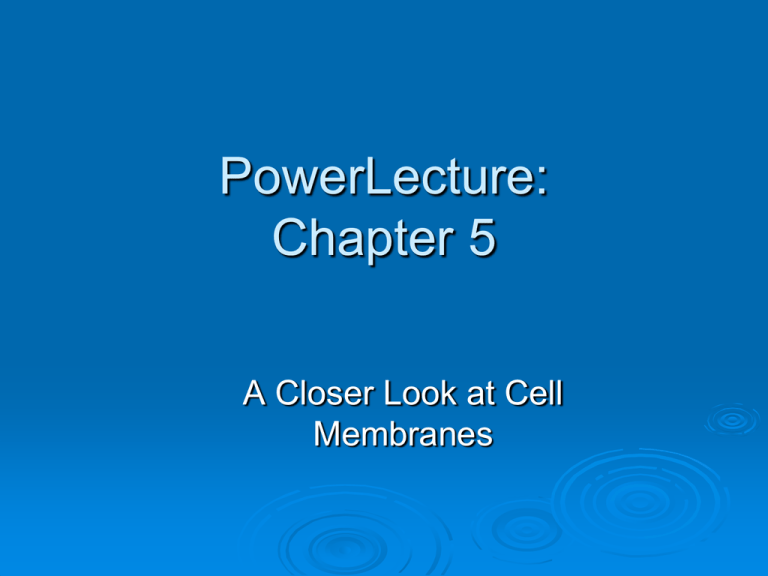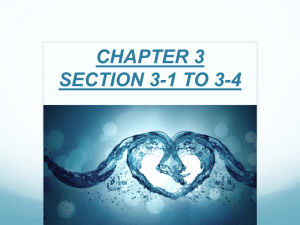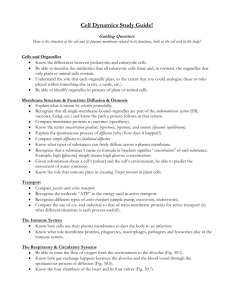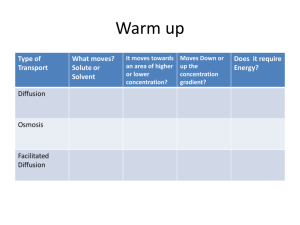Ch. 5 ppt
advertisement

PowerLecture: Chapter 5 A Closer Look at Cell Membranes Impacts, Issues: One Bad Transporter and Cystic Fibrosis CFTR is a protein channel for chloride ions CFTR is a type of ABC transporter in all prokaryotic and eukaryotic cells ATP ATP Fig. 5.2, p.75 Impacts, Issues: One Bad Transporter and Cystic Fibrosis Cystic fibrosis, the most common fatal genetic disorder in the U.S., results from a mutation in CFTR gene Section 5.1: Lipid Bilayer Basic framework Selectively permeable Two layers of phospholipids http://www.bioteach.ubc.ca/Bioindustry/Inex/graphics/lipidbilayer.gif Hydrophilic heads Hydrophobic tails Fluid Mosaic Model Every cell membrane has a mixed composition of phospholipids, glycolipids, sterols, and proteins Most phospholipids and some proteins can drift through membrane Overview of Membrane Proteins Receptor Proteins Recognition Proteins Passive Transporters Active Transporters Fig. 5.6, p.79 Overview of Membrane Proteins Adhesion Proteins Communication Proteins Fig. 5.6, p.78 Transport Proteins Span the lipid bilayer Passive Ion selective (nerve and muscle cells) Change shape when they interact with solute • GluT1 (glucose transporter) Cotransporter Active Pump solute (calcium pump, ATPase) Other Proteins Receptor -- Bind an extracellular substance that triggers changes in cell activity Antibody Recognition HLAs for tissue defense Adhesion – ID tags for species – one cell bind to another collagen Communication – channel between 2 cells Cardiac gap junction Section 5.3: Concentration Gradient Different in #/unit volume of a substances between 2 regions Will move down “down” gradient Diffusion Movement of like molecules or ions down a gradient Molecules move on their own gradient Factors Affecting Diffusion Rate Steepness of concentration gradient Molecular size Smaller molecules, faster diffusion Temperature Steeper gradient, faster diffusion Higher temperature, faster diffusion Electrical or pressure gradients Cell Membranes Show Selective Permeability Some substances enter, but not others Vital to maintaining homeostasis Allows NP Impermeable to ions & lg Polar Section 5.5: Osmosis Diffusion of water molecules across a selectively permeable membrane • Direction of net flow is determined by water concentration gradient • Side with the most solute molecules has the lowest water concentration water molecules semipermeable membrane between two compartments protein molecules Tonicity Refers to relative solute concentration of two fluids Hypotonic - having fewer solutes Hypertonic - having more solutes Isotonic - having same amount Tonicity and Osmosis 2% sucrose solution 1 liter of distilled water 1 liter of 10% sucrose solution Hypotonic Conditions Hypertonic Conditions 1 liter of 2% sucrose solution Isotonic Conditions Fig. 5-13, p.85 What type of solution are these cells in? A B C Hypertonic Isotonic Hypotonic Pressure and Osmosis Hydrostatic Pressure exerted by fluid on the walls that contain it The greater the solute concentration of the fluid, the greater the hydrostatic pressure Osmotic pressure pressure Amount of pressure necessary to prevent further increase of a solution’s volume How Organisms Deal with Osmotic Pressure •A protist like paramecium has contractile vacuoles that collect water flowing in and pump it out to prevent them from over-expanding. How organisms deal with Osmotic Pressure • • Salt water fish pump salt out of their specialized gills so they do not dehydrate. Animal cells are bathed in blood. Kidneys keep the blood isotonic by remove excess salt and water. Bacteria and plants have cell walls that prevent them from over-expanding. In plants the pressure exerted on the cell wall is called tugor pressure. Increase in Fluid Volume first compartment hypotonic solution second compartment hypertonic solution membrane permeable to water but not to solutes fluid volume rises in second compartment Fig. 5.14, p.85 Section 5.4: Passive Transport Flow of solutes through the interior of passive transport proteins down their concentration gradients Passive transport proteins allow solutes to move both ways Does not require any energy input Passive Transport glucose transporter solute (glucose) high low Stepped Art Fig. 5.10, p.80 Facilitated Diffusion Help move specific solutes down the gradient Can be gated Active Transport Net diffusion of solute is against concentration gradient Transport protein must be activated ATP gives up phosphate to activate protein Binding of ATP changes protein shape and affinity for solute Active Help specific solutes diffuse against the gradient Active Transport higher calcium concentration ATP Pi ADP Stepped Art Fig. 5-11, p.83 Active Transport ATP gives up phosphate to activate protein Binding of ATP changes protein shape and affinity for solute Types of Cellular Transport Passive Transport cell doesn’t use energy 1. 2. 3. Diffusion Facilitated Diffusion Osmosis high low Active Transport cell does use energy 1. 2. 3. Protein Pumps Endocytosis Exocytosis •Animations of Active Transport & Passive Weee Transport e!!! high This is gonna be hard work!! low Other types Endocytosis (vesicles in) Exocytosis (vesicles out) Fig. 5-9, p.81 Section 5.6: Endocytosis and Exocytosis Exocytosis: A cytoplasmic vesicle fuses with the plasma membrane and contents are released outside the cell Endocytosis A small patch of plasma membrane sinks inward and seals back on itself, forming a vesicle inside the cytoplasm – membrane receptors often mediate this process Macrophage engulfing Leishmania mexicana parasite macrophage Fig 5.17, p.87 endocytosis a exocytosis 5.6 Traffic to and From the Cell coated pit b d e c f Endocytosis and Exocytosis Fig. 5-15, p.86 How Proteins Get to the Surface vesicle membrane fuses with plasma membrane Golgi body endoplasmic reticulum Fig. 5.18, pg. 87 Endocytosis of cholesterol plasma membrane cholesterol








